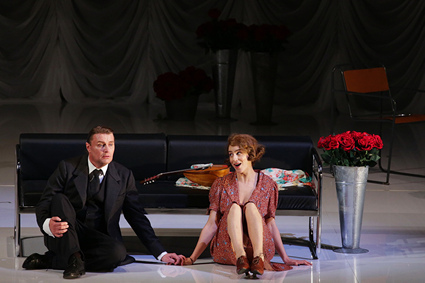| Opera Reviews | 5 May 2024 |
Die Tote Stadt receives its company premiere at La Scalaby Silvia Luraghi |
|
| Korngold: Die Tote Stadt Teatro alla Scala, Milan 7 June 2019 |
|

Klaus Florian Vogt (Paul), Asmik Grigorian (Marie)
|
|
|
Erich Wolfgang Korngold’s Die tote Stadt had its company premiere at La Scala on May 28th, and received unanimous praise form reviewers and critics. The three-act opera, which was first presented in 1920, when the composer was 23 years old, is deeply rooted in cultural and philosophical developments of its time, as much as it can be dubbed as a psychoanalytical opera. The main protagonist, Paul, has turned his home into a sort of shrine for his wife, Marie, whose death he cannot accept. When he meets the young dancer Marietta, he invites her to his home, convinced that she is indeed Marie. After their first meeting Paul has visions of Marie’s ghost that he sees sending contrasting messages: not to forget her, and in the meantime to move on with his life. Even after Marietta has moved in with him, he cannot get rid of his visions, and ends up killing Marietta using his wife’s hair lock as a noose. But this also belongs to his visions: Marietta has simply left, and when she passes by to pick up her umbrella, Paul finally understands that he must move on with his life. The libretto is based on the symbolistic novel Bruges-la-Morte by Georges Rodenbach, which had appeared about 30 years earlier. In Rodenbach’s novel, the town of Bruges (the dead town of the title), is the real protagonist that the author describes as almost human, with its foggy atmosphere and its stillness that are mirrored in Paul’s feelings and in his actions. In the libretto, written by the composer and his father under the pseudonym of Paul Schott, the town of Bruges remains an important element of the plot, but provides a background, and loses the centrality it had in the original novel. On the other hand, the characters show more of an expressionism and verismo facet, as does the music, that combines late Romantic with verismo style (notably, a reduction of the score had been played by the composer for Puccini who was greatly impressed by it). For the Milan production, stage director Graham Vick, with set and costume designer Stuart Nunn, chose to highlight the expressionistic component of Korngold’s work, with the gloomy atmosphere of the dead town replaced by flashing lights and shiny costumes, and scenes remindful of Berlin’s cabaret scene in the 1930s, especially in the second act, when the action moves to the theater where Marietta is performing Robert le diable with her company. In the background, in the third act, a group of Jews move silently towards deportation camps. Vick tried to put together a number of items that would remind the audience of the times of the composer, whose music was banned by Hitler forcing him to move to Hollywood to continue his career composing film music, but this is at odds with the time of composition, much earlier than the events hinted to in the production. The cast was dominated by soprano Asmik Grigorian, who did not only display a perfectly tuned, sizeable voice, with shining high notes, but also proved a great performer when portraying the uninhibited dancer. At her side, tenor Klaus Florian Vogt was a puzzled Paul, not always at ease in the very high tessitura. Baritone Markus Werba was luxury casting for the double role of Paul’s friend Frank and Fritz, a member of Marietta’s theater company. Conductor Alan Gilbert led the orchestra of Teatro alla Scala, which proved up to the challenge of an unfamiliar score, and the musical side was perhaps the most compelling part of the performance. I have already mentioned the enthusiastic reviews: as for the audience, the opera encountered a warm reception, but large sectors of the theater remained empty. As I was at La Scala on a subscription night, this does not do credit to subscribers.
|
|
| Text ©
Silvia Luraghi Photo © Brescia Amisano / Teatro alla Scala |
|







